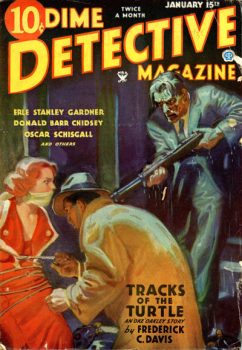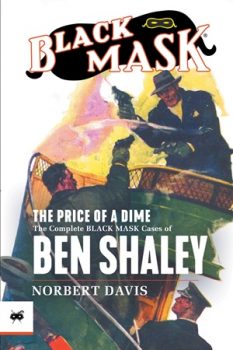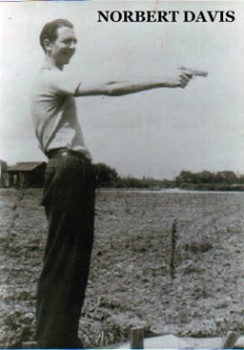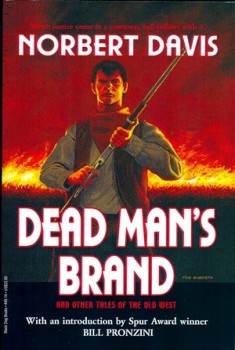A (Black) Gat in the Hand: Norbert Davis’ “The Gin Monkey”
 “You’re the second guy I’ve met within hours who seems to think a gat in the hand means a world by the tail.” – Phillip Marlowe in Raymond Chandler’s The Big Sleep
“You’re the second guy I’ve met within hours who seems to think a gat in the hand means a world by the tail.” – Phillip Marlowe in Raymond Chandler’s The Big Sleep
(Gat — Prohibition Era term for a gun. Shortened version of Gatling Gun)
There will be more pulp Robert E. Howard this summer, but this week, it’s back to the Mean Streets I’m actually (semi-) qualified to write about. And I do know my Norbert Davis; and Dime Detective! This is my seventh Davis essay. And I’ve written two book introductions, with more coming. I’m doing what I can to drum up interest in the massively under-appreciated pulpster.
Black Mask originated, and then dominated, the hardboiled pulp field. In early 1923, Carroll John Daly brought Three gun Terry Mack, and then Race Williams to the page. In October, Dashiell Hammett (writing as Peter Collinson) introduced the more-developed Continental Op. Black Mask would focus on the newly created sub-genre, Joseph ‘Cap’ Shaw would become editor, and the magazine would dominate the mystery field for the rest of the decade. The field was emulating, and looking up at, Black Mask.
Dime Detective hit newsstands in November of 1931. The pulp would become Black Mask’s most enduring competition. In fact, Black Mask would be bought by Dime Detective’s publisher and the latter would outlast the legendary magazine. Stories would be parceled out between the two magazines, and there wasn’t much of a difference, other than which characters could be found in which one.
Editor Kenneth S. White was given marching orders to lure as many Black Mask writers as he could, offering an extra penny a word – a palpable pulp inducement! Most pulps paid one (or even less!) cent per word. Two cents was a desirable wage, which is why so many of the successful pulpsters turned out such prodigious word counts. They needed to just to make a living. Black Mask paid three cents a word, indicative of its status and quality. Dime Detective offering an extra penny a word was significant bait.
Many of Black Mask’s writers jumped ship: Erle Stanley Gardner, Frederick Nebel, Carroll John Daly, T.T. Flynn, and Frederick C. Davis among them. When Shaw was relieved of duties in 1936 in a pay dispute, Raymond Chandler would quit Black Mask and write for Dime Detective.
Billing itself as “twice as good for half the price” (Black Mask cost twenty cents), Dime Detective lasted until August, 1953, by which time the paperback revolution had killed the pulps. Black Mask had packed it in after the March, 1950 issue.
Norbert Davis, whose hardboiled humor wasn’t to editor Cap Shaw’s taste, flourished at Dime Detective. Bail Bond Dodd and Max Latin both made multiple appearances in Dime Detective. You can find a lot about Davis, and his various works, in my other posts, linked below. So, I’ll just hit a few highlights.
Davis grew up in rural Illinois. Good ol’ Abe Lincoln, at 6’4”, towered over his contemporaries. Davis was 6’-5”, and that would have been almost a foot taller than the average American male around him back then. That’s a significant difference. He moved to the West Coast and enrolled at Stanford’s Law School: Davis was no dummy. While a student, he began writing pulp stories, and he was selling them. By the time he graduated in 1934, he was an established pulpster – which of course, wasn’t exactly as lucrative as a successful law career. He had appeared in Black Mask for the first time two years earlier, with “Reform Racket.”
Erle Stanley Gardner was a practicing lawyer as he built his writing career; finally giving up law. Davis took a different approach. An AB (the Latin designation for a BA) and LLD in hand, he never took the bar. Lawyering was not to be Davis’ career path. He would be a professional writer – though, sadly, for not nearly long enough.
He could write straight hardboiled, and he could write screwball hardboiled. Think of them as the hardboiled version of our ‘Right and Left’ political spectrum. I think the ‘center, – hardboiled with humor, but not too much of it – was where he was at his best. Unfortunately, Davis seemed damned with the ‘master of the screwball hardboiled comedy,’ and he is somewhat dismissed because of it.
Recurring characters were a ticket to continued work in the pulps, but Davis didn’t quite follow that path. Bail Bond Dodd appeared in eight issues of Dime Detective, with Benjamin Martin, Doctor Flame, and Max Latin featuring in five stories each. Davis didn’t write about any other character that many times. He seemed to prefer ‘one-offs.’
 Davis moved into the higher payer slicks market in the early forties; possibly pushed along that path by his wife. He did not become a best-selling novelist; Hollywood did not come calling, as it did for many of his contemporaries (one story did become a B-Western); his pulp sales dried up as the industry breathed its last; and it’s rumored he and his wife had a troubled marriage.
Davis moved into the higher payer slicks market in the early forties; possibly pushed along that path by his wife. He did not become a best-selling novelist; Hollywood did not come calling, as it did for many of his contemporaries (one story did become a B-Western); his pulp sales dried up as the industry breathed its last; and it’s rumored he and his wife had a troubled marriage.
He was living in Connecticut with his wife, when he went on his own to Massachusetts in the summer of 1949. On July 28, 1949, he ran a garden hose from the exhaust of his car into the bathroom of his cottage. He died. His estate was valued at $500. He was only 40 years old.
Davis is the third face carved into my Hardboiled Mt. Rushmore – when he was good, he was terrific. In 1934, he had two stories published in 1934: his two Ben Shaley tales. Other than he just wasn’t much of a series guy, I don’t understand why he didn’t write more of them. That was also the year he finished law school, and he really got busy writing as he headed into 1935.
SPOILER ALERT – I get that you probably haven’t read this story, but c’mon: it’s 87 years old. And it’s included in The Complete Cases of Bail-Bond Dodd: Volume 1, from Steeger Books. Unlike a LOT of Davis’s stuff, you can read this one. You have been warned. END SPOILER ALERT
He broke into Dime Detective in January of 1935, with “The Gin Monkey.” It’s a straight hardboiled story, with a touch of humor, but very little. And that from the ‘female secretary’ trope in the opening scene. If you read my other essays, you’ll see that Davis really did receive damning praise that painted him as just a humorous writer. Yes, he was excellent at it. But the guy could hardboil (yes, I just created a verb…)
Max Clark was a one-off character. With Davis, that’s usually what you find. He is also a “consulting criminologist.” Other than the name, I don’t see how this makes him any different from a private eye, unless he was ducking potential State licensing requirements. And that’s just my own speculation. The guy is a detective, using the office of a stenographer as a business address and phone messaging service.
We get a little humor out of Minnie Lander drinking straight gin in her office, early in the day, when Clark comes in. She tells him about a job, and he goes back out. He’s not a guy who sits around his office, waiting for clients, sweating and staring at dust motes in the sunlight.
Edward Salisbury is a drunken artist. He dropped out of site for a few days, and his half-brother Holt, wants him found. A few months before, while trying to pull him out of an opium den, Clark got two bullets in his leg. So, we know this won’t be some simple job. Nice foreshadowing.
“The blinds were down, and it was dark in the room – dark and hot and strong with the smell of stale beer and sawdust.”
Davis is terrific at developing strong supporting characters within the word confines of a short story. But he was also adept at painting an atmosphere. This isn’t a fancy speakeasy.
“Jake was a squatting mound of white in the shadows behind the short, high bar. He was sitting on as tool, leaning backward, with his bald, round head against the cash register. He had a handmade cigarette plastered in one corner of his mouth, and his mouth was open on that side, and air whooshed loudly in and out as he breathed.”
That’s a lot more descriptive than, “He eyed the fat man behind the bar.”
A guy named Borzig runs the place, which isn’t quite a clip joint, but you wouldn’t flash your cash around there, either. Salisbury is passed out drunk in a bedroom with a floozy. Borzig and his right hand man, Tiny, had gotten Salisbury to sign a bunch of blank checks and were cashing them. Nice place, eh? Waving a gun, Marks extracts the happy drunk and takes him home. He also takes Tiny’s gun – that’s not gonna sit well.
On the way back, the barely functioning artist does tell him that he had a commission to create a statue. He made an ugly, yellow and red monkey. During his last big bender, said monkey sat at the end of his hospital bed for two days, and they discussed many things. Yeah… He called it The Gin Monkey, because he had been hammered on gin then.
With one encounter along the way, Marks gets the revived but useless Salisbury back into his apartment. Whereupon, the PI is immediately sapped down by two people, who then cave in the back of the artist’s head. Mission not exactly a rousing success. There’s a broken statue, as if they were looking for something. Hmm…
He visits the dismayed Holt, who tells him, as Paul Harvey would say, ‘The rest of the story.’ Holt met a guy at a bar, who had a great deal on an emerald necklace. Sure, it was hot. But a $15,000 – $20,000 necklace for $2,000? And Holt needed a fancy wedding present for his upcoming nuptials. What could go wrong?
Well, shortly thereafter, the seller, a master thief named Kiley, is found dead, down by the docks, his throat cut. And then, he got a visit from a man who said that he had stolen the necklace with Kiley, who then ripped him off. Holt owed him another $2,000, which he refused to pay. Threats ensued, and Holt had his half-brother make a statue with the necklace hidden in it. Then he can easily carry it around. In a brightly colored, hideous foot+tall statue. Yeah. That’s very low key.
I’m not gonna spoil the rest of the story. Marks does some detective work, puts together some facts, and ends up engaging in some gun play with a couple tough guys.
“Max Clark was already moving when the door squeaked. He shoved his gun straight up in the air and hit the electric light bulb with the short barrel and felt the thudding shock of electricity against his hand and wrist. Then he crouched down, balancing himself with one hand on the floor beside him. All this happened in split seconds, while the echoes of the shots were roaring in clashing echoes between the close walls of the small hallway, and Borzig was whimpering and squirming on the floor and beating his fists against the wall.”
Just one paragraph and one sentence prior, it had been a tense, quiet hallway scene. Then, the action exploded.
He finds the statue, and then there’s an O. Henry twist at the end. I saw it coming, but not all the details. One problem with the short story format of the pulps, is that there’s often a big expository info dump. Often at the end. When Nero Wolfe gathers everyone together and does it in a novel, it works. The longer format frames it better.
In a short story, it often feels like a lot of talking. Davis wasn’t immune to this. It doesn’t kill the story, but it does feel like it slows things down. This isn’t one of Davis’ best, but it’s still a good hardboiled detective story.
It certainly brings to mind Sherlock Holmes’ “The Six Napoleons” And a little bit, the Hercule Poirot story, “The Hollow.”
He continued to write for the pulps into the early forties, and wrote three novels featuring Doan and Carstairs. The latter is a Great Dane with an amazing ability to express his disapproval of Doan’s actions. These books are the poster novels for screwball comedy. He landed some stories in the higher-paying slick, Argosy: and then in the prestigious Saturday Evening Post. But sales dried up, he may have been having marital problems, and he killed himself in 1950.
Davis appeared in Dime Detective nineteen times. With his eight appearance post-Shaw, that exceeds the thirteen Black Mask stories
Dashiell Hammett’s image is the first one carved in my Hardboiled Mt. Rushmore. Next, is Frederick Nebel’s. And third, it’s Davis (the fourth rotates, but is often Raoul Whitfield for his terrific Jo Gar series). Like most pulpsters, Davis left behind a mix of good and bad stories. Even the best were cranking them out at such volume, there were some misses. But when Davis was good, he was one of the best.
Prior Davis posts:
 A (Black) Gat in the hand: Norbert Davis’ Ben Shaley
A (Black) Gat in the hand: Norbert Davis’ Ben Shaley
A (Black Gat in the Hand: Norbert Davis goes West(ern)
A (Black) Gat in the Hand: Norbert Davis – ‘Have one on the House’
A (Black) Gat in the Hand: Norbert Davis – ‘Don’t You Cry for Me’
A (Black) Gat in the Hand: The Forgotten Black Masker – Norbert Davis
A (Black) Gat in the Hand: Norbert Davis in Black Mask – Volume 1
Prior posts in A (Black) Gat in the Hand – 2022 Series (5)
Asimov – Sci Fi Meets the Police Procedural
The Adventures of Christopher London
Weird Menace from Robert E. Howard
Spicy Adventures from Robert E. Howard
Thrilling Adventures from Robert E. Howard
Prior posts in A (Black) Gat in the Hand – 2021 Series (8)
The Forgotten Black Masker – Norbert Davis
Appaloosa
A (Black) Gat in the Hand is Back!
Black Mask – March, 1932
Three Gun Terry Mack & Carroll John Daly
Bounty Hunters & Bail Bondsmen
Norbert Davis in Black Mask – Volume 1
Prior posts in A (Black) Gat in the Hand – 2020 Series (19)
Hardboiled May on TCM
Some Hardboiled streaming options
Johnny O’Clock (Dick Powell)
Hardboiled June on TCM
Bullets or Ballots (Humphrey Bogart)
Phililp Marlowe – Private Eye (Powers Boothe)
Cool and Lam
All Through the Night (Bogart)
Dick Powell as Yours Truly, Johnny Dollar
Hardboiled July on TCM
YTJD – The Emily Braddock Matter (John Lund)
Richard Diamond – The Betty Moran Case (Dick Powell)
Bold Venture (Bogart & Bacall)
Hardboiled August on TCM
Norbert Davis – ‘Have one on the House’
with Steven H Silver: C.M. Kornbluth’s Pulp
Norbert Davis – ‘Don’t You Cry for Me’
Talking About Philip Marlowe
Steven H Silver Asks you to Name This Movie
Cajun Hardboiled – Dave Robicheaux
More Cool & Lam from Hard Case Crime
A (Black) Gat in the Hand – 2019 Series (15)
Back Deck Pulp Returns
A (Black) Gat in the Hand Returns
Will Murray on Doc Savage
Hugh B. Cave’s Peter Kane
Paul Bishop on Lance Spearman
A Man Called Spade
Hard Boiled Holmes
Duane Spurlock on T.T. Flynn
Andrew Salmon on Montreal Noir
Frank Schildiner on The Bad Guys of Pulp
Steve Scott on John D. MacDonald’s ‘Park Falkner’
William Patrick Murray on The Spider
John D. MacDonald & Mickey Spillane
 Norbert Davis goes West(ern)
Norbert Davis goes West(ern)
Bill Crider on The Brass Cupcake
A (Black) Gat in the Hand – 2018 Series (32)
George Harmon Coxe
Raoul Whitfield
Some Hard Boiled Anthologies
Frederick Nebel’s Donahue
Thomas Walsh
Black Mask – January, 1935
Norbert Davis’ Ben Shaley
D.L. Champion’s Rex Sackler
Dime Detective – August, 1939
Back Deck Pulp #1
W.T. Ballard’s Bill Lennox
Day Keene
Black Mask – October, 1933
Back Deck Pulp #2
Black Mask – Spring, 2017
‘Max Allen Collins & The Hard Boiled Hero’
A (Black) Gat in the Hand: William Campbell Gault
A (Black) Gat in the Hand: More Cool & Lam From Hard Case Crime
MORE Cool & Lam!!!!
Thomas Parker’s ‘They Shoot Horses, Don’t They?’
Joe Bonadonna’s ‘Hardboiled Film Noir’ (Part One)
Joe Bonadonna’s ‘Hardboiled Film Noir’ (Part Two)
William Patrick Maynard’s ‘The Yellow Peril’
Andrew P Salmon’s ‘Frederick C. Davis’
Rory Gallagher’s ‘Continental Op’
Back Deck Pulp #3
Back Deck Pulp #4
Back Deck Pulp #5
Joe ‘Cap’ Shaw on Writing
Back Deck Pulp #6
The Black Mask Dinner
 Bob Byrne’s ‘A (Black) Gat in the Hand’ made its Black Gate debut in 2018 and has returned every summer since.
Bob Byrne’s ‘A (Black) Gat in the Hand’ made its Black Gate debut in 2018 and has returned every summer since.
His ‘The Public Life of Sherlock Holmes’ column ran every Monday morning at Black Gate from March, 2014 through March, 2017. And he irregularly posts on Rex Stout’s gargantuan detective in ‘Nero Wolfe’s Brownstone.’ He is a member of the Praed Street Irregulars, founded www.SolarPons.com (the only website dedicated to the ‘Sherlock Holmes of Praed Street’) and blogs about Holmes and other mystery matters at Almost Holmes.
He organized Black Gate’s award-nominated ‘Discovering Robert E. Howard’ series, as well as the award-winning ‘Hither Came Conan’ series.
He has contributed stories to The MX Book of New Sherlock Holmes Stories – Parts III, IV, V, VI and XXI.
He has written introductions for Steeger Books, and appeared in several magazines, including Black Mask, Sherlock Holmes Mystery Magazine, The Strand Magazine, and Sherlock Magazine.